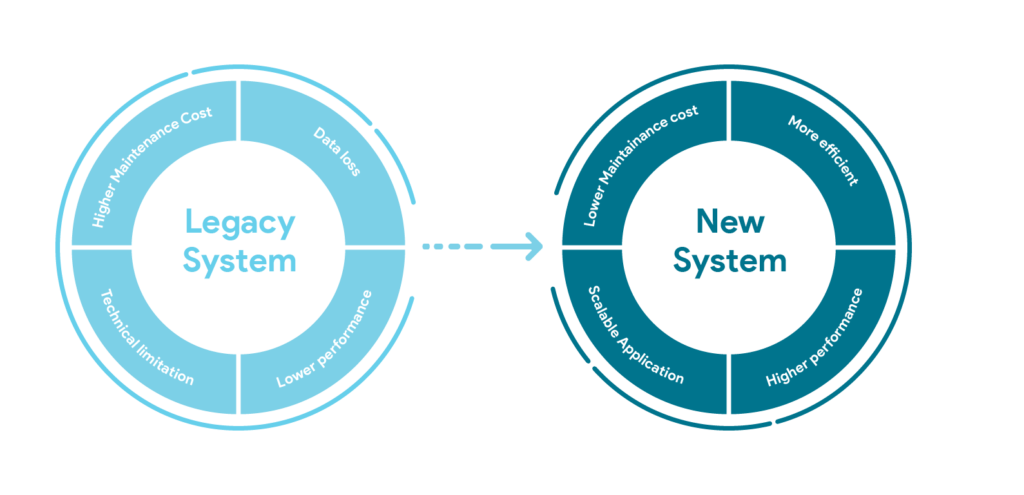Insights
New organizations are joining the business landscape looking to change the status quo. They come with a new approach to customer acquisition and retention or deliver goods and services in different and efficient ways, which shake up the established businesses. Consequently, digital transformation has become a focal point for mature businesses seeking a digital response to these new forces.
But these mature businesses have an obstacle in their way: their legacy systems. Actually half of these businesses named legacy systems as their primary blocker to implementing a digital transformation strategy when questioned in a survey by Nimbus Ninety.
Deloitte also indicated technological relevance as the second most selected business driver. Legacy solutions lack flexibility and carry a significant technology debt due to dated languages, databases, architectures, and a limited supply of programmers for their outdated software. This prevents many organizations from advancing and supporting analytics, real-time transactions, and a digital experience. Two-thirds of the companies surveyed pointed towards technology as a business driver, coming second to product strategy and objectives in the Deloitte study.
Unfortunately, many of today’s businesses are caught in their technology investments of the past that contain the data needed to make decisions and drive insights.
But there is a misperception that digitization has to raze the existing technology and start over. The scale of such an endeavor discourages companies and keeps them captive in outdated systems.
The good news is that in some situations companies don’t actually have to reinvent their entire digital infrastructure to take advantage of modern technology. There are ways to adapt legacy systems to meet the demands of today’s business world without starting from scratch.

Revolution or evolution?
So the big question on everybody’s lips is: should we throw everything overboard and go for a “new and shiny” digital system altogether or try to patch the existing one? It’s a dilemma that does not have an immediate answer. To make a decision even more difficult, the technology industry fuels the dilemma: move everything to the cloud, invest in platforms, replace legacy systems with SaaS software, start a legacy modernization program or create the next-generation architecture, etc.
The problem with this advice is that it puts technology first. To say it bluntly, it confuses the aim for the means.
All too often organizations are looking at digital transformation as a definitive jump. But the value accumulated within an organization should be put to work in the digital age and wholesale replacement is not always the best strategy.
Some companies do see a need for the agility of modern systems but replacing everything at once would put them in a tight financial spot.
Time and not money can also be an issue holding companies from making the jump. In fields with extremely high operational tempos, there’s no time for a system overhaul. Many legacy systems serve critical functions and switching to a new system—even if it eventually leads to greater efficiency—causes a loss of productivity and revenue.

At the same time, sticking with the old legacy system can be too expensive. Vendor support, hardware maintenance, complexity, and getting technicians for an outdated technology keep adding to the yearly bill and to the ambivalence of the decision-makers.
Set the aim THEN go for the means
There are integration solutions like building wrappers around legacy systems that can leave legacy systems as the foundation and overlay the next-generation platform on top of them. This creates a hybrid system that allows companies to use cutting-edge tools while retaining the functional parts of their legacy system.
The middle ground isn’t easy to find that’s why the experts recommend you start with a complete audit of the company’s technological infrastructure.
Then a strong, proficient team of software engineers that can make the jump from vision to implementation through Agile Digital Transformation is needed. A benchmark case study about system integration for the biggest retailer in Europe can be found here.
Tools like service layers, DAL, APIs, and others can buy you a few more years. This way the power of legacy systems has successfully been harnessed by many organizations and the content or processing power of the systems in place was delivered to their customers through fresh, modern interfaces or mobile apps. It’s an approach that enables organizations to transform their customer experience while using legacy systems to process the inputs. But eventually, the jump into a complete digital transformation must be made.
It should be noted that building onto legacy systems isn’t always an option, the integration solution being extremely situational dependent.
The modern development paradigm aims for highly flexible modular development, but older systems tend to be monoliths. Some legacy systems are too complex or rigid to integrate with new technology.


